
Charles Albert Horner is a retired United States Air Force four-star general. He was born in Davenport, Iowa and attended the University of Iowa, as part of the Air Force Reserve Officers' Training Corps program. On June 13, 1958, Horner was commissioned into the Air Force Reserve. During the Vietnam War, he flew in combat as a Wild Weasel pilot and received the Silver Star. During Operation Desert Shield and Operation Desert Storm, he commanded the American Air Force, as well as those of the American allies. During the Desert Shield phase of the conflict, Horner briefly served as Commander-in-Chief — Forward of United States Central Command; while General Norman Schwarzkopf, Jr. was still in the United States. He currently serves on the board of directors for the United States Institute of Peace.
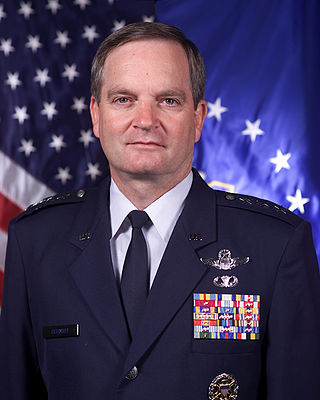
Randall Mark Schmidt was a lieutenant general in the United States Air Force.

Ralph Edward "Ed" Eberhart is a retired four-star general in the United States Air Force (USAF). He served as the commander of North American Aerospace Defense Command (NORAD) and United States Northern Command, Peterson Air Force Base, Colorado. He was in charge of NORAD during the September 11 attacks in 2001.
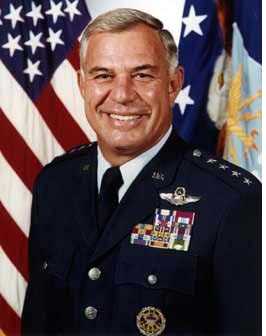
General John George Lorber was a retired four-star general in the United States Air Force (USAF). He served as commander of Pacific Air Forces, Hickam Air Force Base, Hawaii. As commander, he had responsibility for USAF activities spread over half the world in a command that supports 44,000 airmen serving principally in Hawaii, Alaska, Guam, Republic of Korea and Japan.

Brigadier General Antonio Maldonado was an officer of the United States Air Force, who in 1967 became the youngest pilot and Aircraft Commander of a B-52 Stratofortress nuclear bomber. He served as Chief, U.S. Office of Defense Cooperation, Madrid, Spain. He was the senior Department of Defense representative to Spain and senior advisor to the US Ambassador to Spain. During the Persian Gulf War in 1991 he coordinated the overall US offensive operations from Spain.
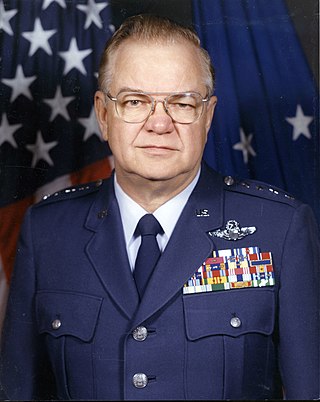
William Leslie Kirk was a four-star general in the United States Air Force (USAF). He served as Commander in Chief, United States Air Forces in Europe/Commander, Allied Air Forces Central Europe (CINCUSAFE/COMAAFCE) from 1987 to 1989.

Jimmie Vick Adams is a retired four-star general in the United States Air Force (USAF). He served as commander in chief, Pacific Air Forces (CINCPACAF) from 1991 to 1993.
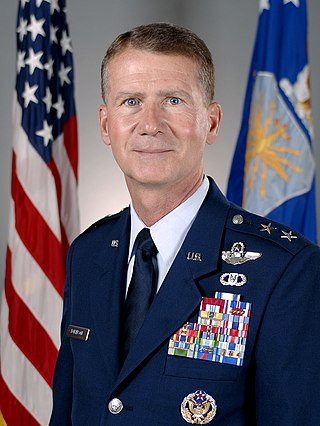
David A. Robinson is a retired major general in the United States Air Force who served as mobilization assistant to the Chief of the Air Force Reserve, Headquarters United States Air Force, Washington, D.C.
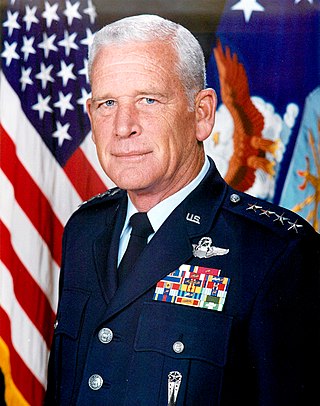
Robert Lynn Rutherford was a general in the United States Air Force who served as commander of the United States Transportation Command and of Pacific Air Forces. He was born in Luling, Texas.
Hispanics in the United States Air Force can trace their tradition of service back to the United States Army Air Forces (USAAF), the military aviation arm of the United States Army during and immediately after World War II. The USAAF was the predecessor of the United States Air Force, which was formed as a separate branch of the military on September 18, 1947, under the National Security Act of 1947. In the U.S., the term Hispanic categorizes any citizen or resident of the United States, of any racial background, of any country, and of any religion, who has at least one ancestor from the people of Spain or is of non-Hispanic origin but has an ancestor from Mexico, Puerto Rico, Cuba, Central or South America, or some other Hispanic origin. The three largest Hispanic groups in the United States are the Mexican-Americans, Puerto Ricans, and Cubans. According to the U.S. Census Bureau the estimated Hispanic population of the United States is over 50 million, or 16% of the U.S. population, and Hispanics are the nation's largest ethnic minority. The 2010 U.S. census estimate of over 50 million Hispanics in the U.S. does not include the 3.9 million residents of Puerto Rico, thereby making the people of Hispanic origin the nation's largest ethnic or race minority as of July 1, 2005.

John Wendell Roberts was a United States Air Force general and commander of the Air Training Command with headquarters at Randolph Air Force Base, Texas. He had a bachelor of science degree from Minnesota State University, Mankato and a master's degree from The George Washington University. He was also a graduate of the Air Command and Staff College and the National War College.

Billy Martin Minter was a four-star general in the United States Air Force (USAF). He served as commander in chief, United States Air Forces in Europe and commander of Allied Air Forces Central Europe, with headquarters at Ramstein Air Base, West Germany.

Jack Irvin Gregory is a former general in the United States Air Force and the former commander in chief of the Pacific Air Forces.

George Gilmer Loving Jr. was a United States Air Force lieutenant general who served as commander, United States Forces Japan and Fifth Air Force, with headquarters at Yokota Air Base, Japan. As commander, he was the senior United States military representative in Japan and responsible for all United States air units in Japan and the Republic of Korea.

Thomas Joseph "Tom" Masiello is a retired United States Air Force Major General who served as the eighth commander of the US Air Force Research Laboratory. He is a member of the Society of Experimental Test Pilots.

Marc Henry Sasseville Frontera is a United States Air Force lieutenant general who currently serves as the 12th Vice Chief of the National Guard Bureau. He previously served as the commander of the Continental United States North American Aerospace Defense Command Region and concurrently as commander of the First Air Force from June 2019 to August 2020. Sasseville previously served as commander of the 113th Wing, District of Columbia Air National Guard at Andrews Air Force Base in Maryland and was the first Hispanic American to hold the position. On September 11, 2001, Sasseville was the acting operations group commander under the 113th Wing of the D.C. Air National Guard. He was one of four pilots given the mission of finding United Airlines Flight 93 during the September 11 attacks and destroying it, even if it meant ramming the aircraft. He also served as the Senior Defense Official/Defense Attache, Turkey, United States European Command, Ankara, Turkey. He assumed his current assignment in August 2020.

James Robert Brown was a lieutenant general in the United States Air Force who served as vice commander of Tactical Air Command, with headquarters at Langley Air Force Base, Virginia. The command comprises more than 118,000 military and civilian personnel, stationed at 18 major Tactical Air Command installations and other units in the United States, Panama, Okinawa and Iceland. Tactical Air Command was the operational combat organization for 74,000 Air National Guard and Air Force Reserve personnel throughout the United States.

Craven C. Rogers Jr. was a lieutenant general in the United States Air Force who served as deputy commander in chief of the U.S. Central Command at MacDill Air Force Base, Florida. The command was tasked with achieving United States national objectives in Southwest Asia, the Persian Gulf, and the Horn of Africa. Rogers was born in 1934, in Galveston, Texas. He earned a Bachelor of Science degree in engineering from the U.S. Military Academy in 1957 and a master's degree in business administration from The George Washington University. He completed Squadron Officer School in 1962 and the Industrial College of the Armed Forces in 1973. Upon graduation from the academy he was commissioned as a second lieutenant in the Air Force. After completing pilot training in September 1958 he was assigned to Tactical Air Command at Williams Air Force Base, Ariz., for gunnery training in the F-86F. With the phaseout of the F-86F, Rogers transferred in June 1959 as an instructor pilot to Air Training Command, Vance Air Force Base, Oklahoma. He completed F-101A transition training in September 1964 and then was assigned as a tactical fighter pilot with the 91st Tactical Fighter Squadron, Royal Air Force Station Bentwaters, England. In 1965 his squadron became the first unit in the United States Air Forces in Europe to transition to the F-4. Rogers assumed duties in the Standardization and Evaluation Section of the 81st Tactical Fighter Wing at Bentwaters in November 1966. In September 1967 he transferred to Nellis Air Force Base, Nevada, where he completed the F-4 Fighter Weapons School. In January 1968 he was assigned to the 557th Tactical Fighter Squadron, 12th Tactical Fighter Wing, Cam Ranh Bay Air Base, South Vietnam, as a flight commander and squadron weapons officer. He subsequently served as the wing weapons officer and assistant chief of weapons and tactics for 12th Tactical Fighter Wing. He flew 255 combat missions and 435 combat flying hours in the F-4C. He returned from Southeast Asia in February 1969 and was assigned to the Fighter and Reconnaissance Manning Section, Air Force Military Personnel Center, Randolph Air Force Base, Texas. He became chief of the section in 1971. Upon graduation from the Industrial College of the Armed Forces in August 1973, Rogers became deputy commander for operations, 1st Tactical Fighter Wing, MacDill Air Force Base, Florida. In June 1975 he transferred to Headquarters United States Air Force, Washington, D.C., as chief, Tactical Division, Directorate of Operational Requirements, Office of the Deputy Chief of Staff, Research and Development. In July 1977 Rogers was assigned as vice commander of the 4th Tactical Fighter Wing, Seymour Johnson Air Force Base, North Carolina. In June 1978 he became commander of the wing. He returned to Air Force headquarters in July 1980 and served as military assistant to the secretary of the Air Force. From June 1983 to July 1985 he was commander of United States Air Forces Korea; commander, United Nations Command Air Component; and commander, 314th Air Division, with headquarters at Osan Air Base, South Korea. He also was commander of the Korean Air Defense Sector, director of readiness and combat operations, and chief of staff of the Air Component Command/Combined Forces Command. Rogers then transferred to Hickam Air Force Base, Hawaii, as vice commander in chief, Pacific Air Forces. In December 1986 Rogers returned to Osan Air Base as commander, 7th Air Force; deputy commanding general, U.S. Forces Korea (Seoul); and deputy commander in chief, United Nations Command (Seoul). He is a command pilot with 5,200 flying hours. His military awards and decorations include the Defense Distinguished Service Medal with oak leaf cluster, Distinguished Service Medal, Legion of Merit with two oak leaf clusters, Distinguished Flying Cross with oak leaf cluster, Bronze Star Medal, Meritorious Service Medal with oak leaf cluster, Air Medal with 13 oak leaf clusters, Air Force Commendation Medal, Korean Order of National Security Merit (Chunsu) and Korean Order of National Security Merit (Kuksun). He was promoted to lieutenant general January 1, 1987, with same date of rank. He retired on April 1, 1991, and died on August 4, 2016.
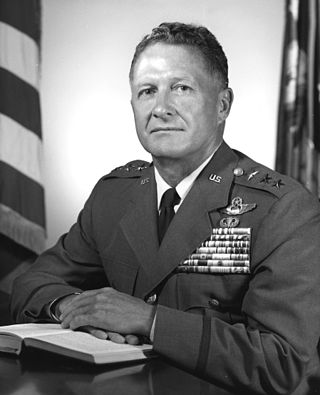
Gordon Marion Graham was a United States Air Force lieutenant general. Graham was a combat pilot who, during World War II was credited with 7 aerial victories making him a flying ace. He is credited with a further 9.5 aircraft destroyed on the ground. By the end of World War II, Graham had flown 73 combat missions in the P-51 Mustang.

Melbourne Kimsey is a retired brigadier general in the United States Air Force who served as director of the Cheyenne Mountain Complex from 1981 to 1983,





















